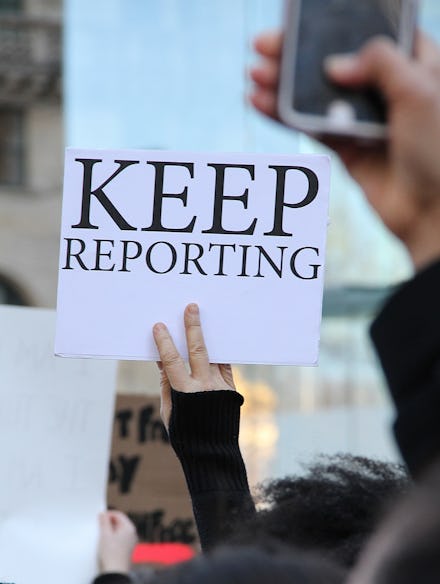In the age of Trump, 24 journalism groups team up to track press freedom violations

When Montana Rep. Greg Gianforte body-slammed Guardian reporter Ben Jacobs the day before his successful election in May, journalists and press freedom advocates wrung their hands over what they said was a continued deterioration of press freedom in the United States.
Gianforte’s assault on Jacobs, to which he pleaded guilty, was plastered across the news. But since the beginning of the year, there have been 10 other instances of physical assaults on journalists across the country, many of which have largely flown under the radar.
A new website called Press Freedom Tracker aims to make it easier for journalists, advocates and the general public to keep track of press freedom violations, ranging from physical assaults like the Gianforte case to criminal charges against journalists like Mic reporter Jack Smith IV, who was arrested and charged with obstruction while covering Standing Rock protests. The site will also track instances of journalists being detained, denied access to information, searched or having their equipment seized from them.
The Committee to Protect Journalists, which is funding the site, and the Freedom of the Press Foundation, which will manage the site, are launch partners. Twenty-four press advocacy organizations and journalism groups have joined as partners, including the Knight Institute at Columbia University and the Reporters Committee for Freedom of the Press. These groups will all flag instances of press freedom violations for the database. Journalists can also use a portal on the site’s homepage to submit incidents they’ve experienced or encountered.
The site is being spearheaded by Freedom of the Press senior reporter Peter Sterne. Sterne, with whom this reporter previously worked, will serve as managing editor of the site and will log instances as they are submitted.
Alexandra Ellerbeck, the Committee to Protect Journalists’ senior U.S. researcher who is chairing the steering committee for the database, said that the site is the first of its kind. The goal of the Press Freedom Tracker, she said, is to help improve press freedom advocacy by arming the public with a reliable dataset that puts incidents of press freedom violations in context.
“The other hope is that by creating a coalition project of this sort, is that it helps build the muscles of collaboration that will help strengthen any future action or response from these groups,” Ellerbeck added.
Some of the motivation to launch the tracker stems from the Trump administration’s habit of lobbing verbal attacks on the press. But concerns about press freedom began long before Trump took office, and Ellerbeck stressed that press freedom has historically been nonpartisan.
“I don’t think we woke up on Nov. 9 and realized there was an issue,” Ellerbeck said, citing former President Barack Obama’s crackdown on government leakers during his administration as one pre-Trump example. “But I do think that the current press freedom climate has contributed a lot of energy and focus to the project.”
Ellerbeck said one of the biggest challenges in maintaining the site will be comparing its dataset to those of previous administrations, since the site is only tracking press freedom incidents from Jan. 1, 2017, onward. The decision not to track incidents prior to the beginning of 2017 was based on the challenges of cataloguing and confirming years-old incidents, Ellerbeck said.
But the hope is that as the dataset continues to build, it can serve as a long-term educational tool. Ellerbeck also hopes journalists will submit their own instances so that the dataset is as robust as possible.
Sarah Repucci — senior director of global publications at the nonprofit Freedom House, which is not involved in the tracker — said that the public only stands to benefit from a reliable dataset of press freedom incidents in the U.S., although she stressed that more needs to be done to improve American press freedom.
“It is very important to pinpoint these incidents,” Repucci said. “But these incidents are just the symptoms of a much larger problem in this country.”
Repucci pointed to deteriorating trust in the media as a major challenge to press freedom, which she said is harder to tackle.
“The rhetoric coming from the White House is a problem, but it has exaggerated a problem that was already there,” Repucci said. She later noted, “I think Trump was able to take advantage of that kind of rhetoric because the foundation had already been laid.”
Ellerbeck agreed that Trump’s heightened rhetoric against the media — calling the media “an enemy of the American people,” for instance — isn’t something that an increase in awareness about press freedom can solve. But she said she is hopeful that increased awareness can spur positive changes.
One of the most important things to keep in mind, Repucci and Ellerbeck both said, is that leaders around the world occasionally look to the U.S. as a model for press freedom — for better or worse.